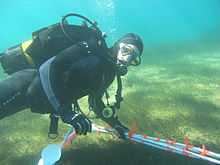Project Seahorse
 The Project Seahorse logo. | |
| Founded | 1996 |
|---|---|
| Founders | Amanda VincentHeather Koldewey |
| Focus | Marine Conservation |
| Location | |
Area served | Worldwide |
| Slogan | A world in which marine ecosystems are healthy and well-managed. |
| Website | |
Project Seahorse is a marine conservation organization committed to the conservation and sustainable use of coastal marine ecosystems in general, and seahorses in particular.
Operations

By working to protect seahorses, Project Seahorse supports marine conservation more broadly. These fish are affected by similar environmental and over-fishing pressures as all marine organisms, and benefit from similar conservation measures. The organization's work focuses on not just biological seahorse research, but marine fish populations, ecosystems, fishing communities, national and global trade issues, and policy and public outreach.
It was founded in 1996 by the seahorse researchers Amanda Vincent and Heather Koldewey. Today, Vincent is the Director, Koldewey the Associate Director, and there are about 35 team members. Field work began in the Philippine community of Handumon on Jandayan Island off the northern tip of Bohol, and has expanded to Europe, Central America, east and southeast Asia, Africa, and North America. Project Seahorse is the IUCN Red List authority on seahorses and their related species.
The project works in cooperation with the UBC Fisheries Centre at the University of British Columbia, where Vincent holds a Canada Research Chair in Marine Conservation; the Zoological Society of London, where Koldewey is Head of Global Programmes; the John G. Shedd Aquarium; and the TRAFFIC network.[1]
In 2006, the project published a history of its first decade, Project Seahorse at 10.
Research
Researchers study the biology, distribution, ecology, habitat, and population numbers of seahorse species around the world. Species researched include these:
- Dwarf seahorse
- Great seahorse
- Japanese seahorse
- Lined seahorse
- Pacific seahorse
- Pygmy seahorses
- Slender seahorse
- Spiny seahorse
- West African seahorse
Achievements
In the Philippines, the project has established 34 locally managed marine protected areas in the Philippines, and encouraged an alliance of 1,000 families of small-scale fishers, KAMADA, active in establishment of marine reserves and enforcement against illegal fishing.[2] The project has obtained an agreement under CITES, the Convention on International Trade in Endangered Species, to limit export of seahorses to sustainable levels, the first global export controls under (CITES for any commercially important marine fish.[3]
Awards
- Association of Zoos and Aquariums Significant Achievement Award for International Conservation for Project Seahorse (2001)
- Grand Prix International pour l’Environment Marin from the Confédération Mondiale des Activités Subaquatiques (1997)
References
- ↑ "ProjectSeahorse.org". History. Retrieved 20 September 2011.
- ↑ "Philippine Seahorses fall victim to overfishing" Philippine Center For Investigative Journalism, 1999
- ↑ "Guylian.com". About Project Seahorse. Guylian Belgian Chocolate. Retrieved 20 September 2011.